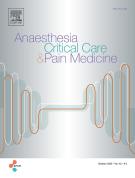Sample size considerations for studies comparing intubating conditions using quantitative monitoring versus a fixed interval during onset of neuromuscular blockade - 24/11/22
 , Catherine Tamrabet a, Samia Ben Abdallah a, Sophie Toussaint a, Chérifa Cheurfa a, b
, Catherine Tamrabet a, Samia Ben Abdallah a, Sophie Toussaint a, Chérifa Cheurfa a, bAbstract |
Introduction |
Data in the literature are still scarce to establish any recommendations on the use of quantitative monitoring during tracheal intubation.
Patients and methods |
In this monocentric study, non-morbidly obese adult female patients without risk factors for difficult tracheal intubation were prospectively included. After 0.5 mg.kg−1 atracurium during propofol-sufentanil anaesthesia, intubation conditions were evaluated using the Copenhague and Cormack-Lehane classification at the complete twitch suppression at the TOF to the AP (monitor group) or after a fixed 3 min waiting time after atracurium injection (3-min group). We also examined sample size for future studies.
Results |
We included 102 (monitor group) and 97 (3-min group) adult non-obese female patients without different characteristics. Intubation conditions were acceptable in 96/102 (94%) in the monitor group vs. 84/97 (87%) in the 3-min group, p = 0.07. The presence of a Cormack and Lehane view of 1 was marginally better in the monitor group as compared to the 3-min group, p = 0.041. We propose two possibility of sample size based on a difference of observed events based on acceptable intubation conditions, n = 602, or on excellent intubation conditions, n = 550.
Discussion |
This observational study shows that the use of a neuromuscular TOF monitoring of the ulnar nerve as compared to a fixed 3-min waiting time after atracurium injection could improve laryngoscopic view and show a tendency to better intubation conditions without conclusive statistical significance. We suggest that researchers consider our recommendations in terms of the sample size to include in their future research, keeping in mind the limitations of our study.
Le texte complet de cet article est disponible en PDF.Keywords : Atracurium, Neuromuscular monitoring, Tracheal intubation
Plan
Vol 41 - N° 6
Article 101154- décembre 2022 Retour au numéroBienvenue sur EM-consulte, la référence des professionnels de santé.
L’accès au texte intégral de cet article nécessite un abonnement.
Déjà abonné à cette revue ?

